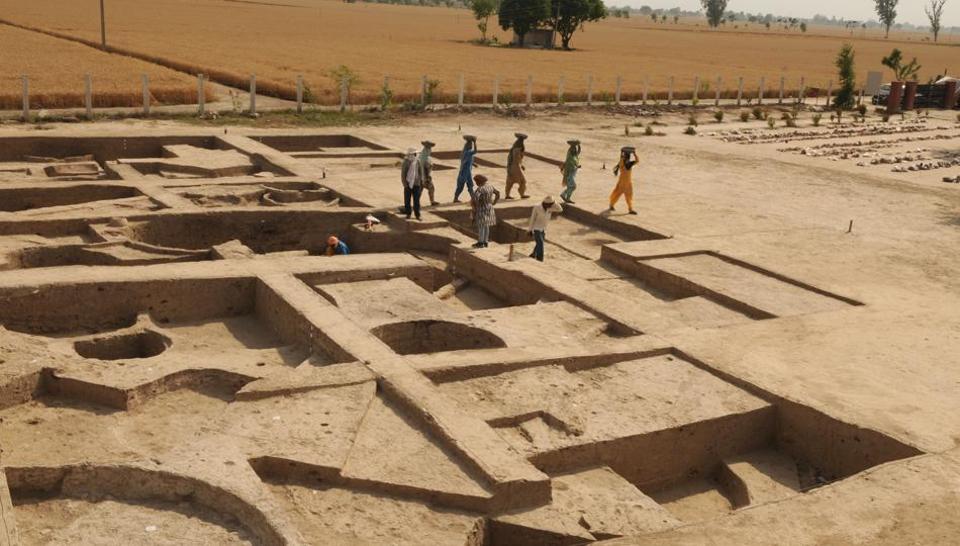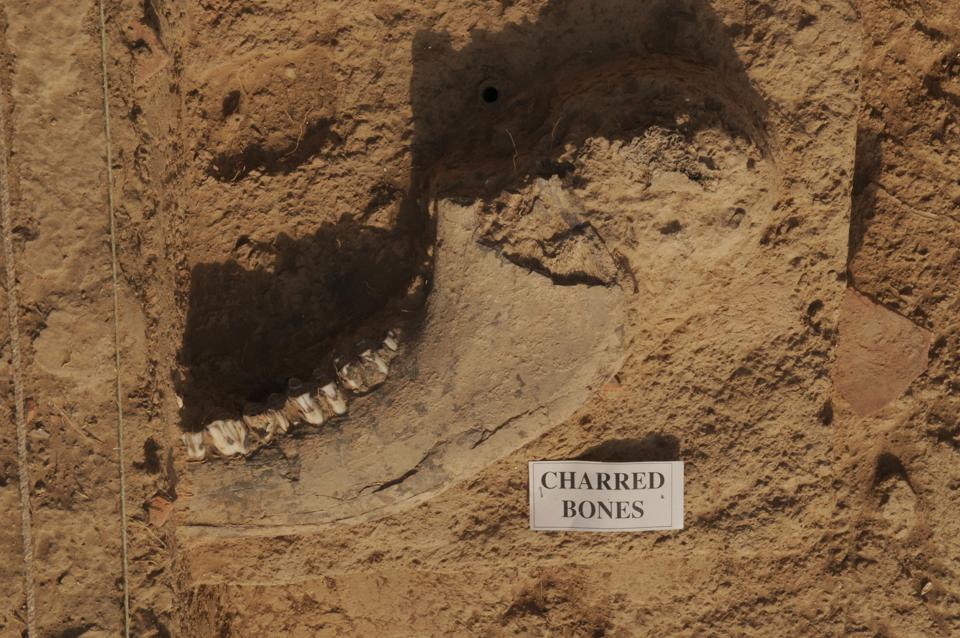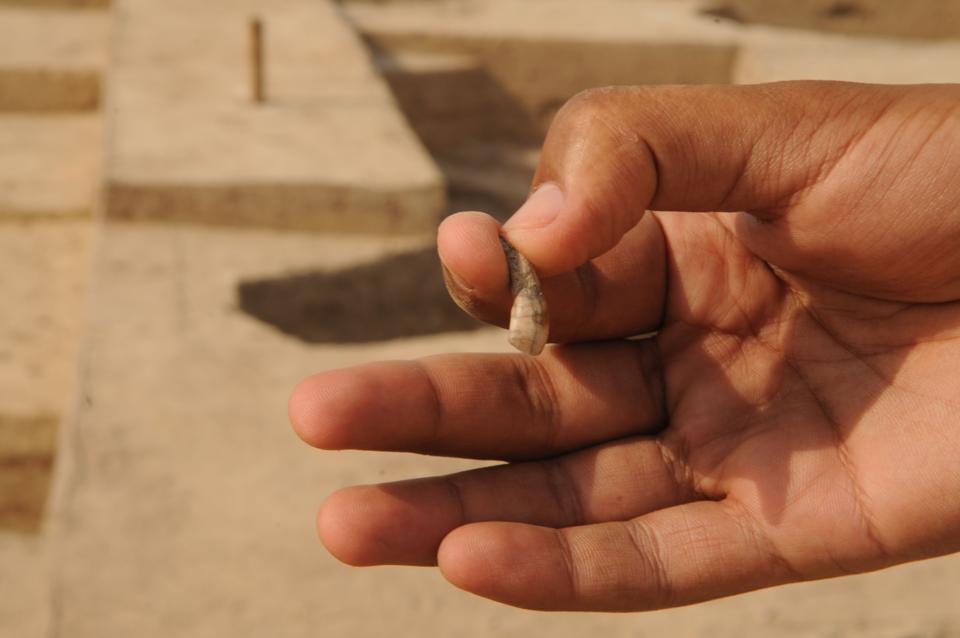Relevant for Mains GS Paper 1
The road that goes from Digoh to Ratia in Fatehabad, more than 220 kilometres away from the heart of Gurugram, bears witness to a sense of quietude on a hot summer day. Flanked by farmlands on both sides, the stretch is largely uneventful and morose, with little human presence owing to the sweltering heat. However, it’s from here that a small detour off the main road leads one to the sleepy village of Kunal. On the face of it, Kunal is much like any other Indian village, except it was once a Harappan village and is imbued in history that predates India’s ancient settlements.
Located at a distance of 12km from Ratia tehsil, Kunal is one of the oldest pre-Harappan settlements and dates back roughly to the 5th millennium BC. The roughly 6,000-year-old site holds within it a rich legacy and its ties to the past can possibly help trace the history of Haryana, and the country. First discovered in 1986, excavations in Kunal have taken place over different seasons in 1992-93, 1996-97, 1998-99, 1999-2000, 2001-2002 and 2002-2003. The seventh round of excavations that started in January ended two weeks ago, and a compilation of the findings are expected to be released in the next one year.
Kunal: The settlement
The presence of the settlement is signalled by a yellow metal board that springs up abruptly on the Digoh-Kunal road. “Harappa Kaleen sthal (Harappan-era site),” is written on the board in Hindi and a painted red arrow below it points in the direction of the site. Flanked by fields, the settlement is just a few hundred metres away from this board. It bears a deserted look for the greater part of the year except when it’s time for excavations. The site has been dug up thrice since 2017 following a Memorandum of Understanding between the Department of Archaeology and Museums, Haryana; the Indian Archaeological Society, New Delhi and National Museum, New Delhi. The recent round of excavation in Kunal started in January this year and concluded in April. The excavations were undertaken to find out more about the original inhabitants of Kunal.
“The prime objective of re-excavating the site was to find out who were the earliest settlers of this area, or Haryana, for that matter. We wanted to know whether they were indigenous people or outsiders who came here and settled. The identity of the occupants is ascertained through the cultural material that is found in different geographical layers. At Kunal, our aim is to know more about Hakra culture and the people who were associated with Hakraware,” said Shubam Malik, technical assistant and excavator at the site.
Culture sans boundaries
Hakraware refers to the cultural material that has been traced to the pre-Harappan phase. The word is a combination of two words: Hakra and ware. While ware means pottery, the word Hakra traces its origins to the palaeochannel of Ghaggar-Hakra that flows through India and Pakistan. The river channel is known as Ghaggar in India and Hakra further downstream in Pakistan.
Hakraware was first traced to Cholistan in Pakistan along the banks of the river Hakra, and Harappan sites in India have also yielded cultural material resembling that of the Cholistan region. The excavations at Kunal were aimed at digging deep into Hakra culture. “When Harappan sites were first excavated in Cholistan, a typical distinctive pottery was found along the banks of the Hakra river. The pottery, however, wasn’t limited to that region alone. When Kunal was surveyed, traces of Hakra culture were found here,” informed Malik.
He added that cultural similarities between the objects unearthed in Pakistan and India had revealed that Hakraware people diffused from the Cholistan region towards Kunal. “Hakraware people came here and settled in this area. They were moving and looking for a land to make settlements. Findings have showed that the people lived here in proper continuity for many years,” added Malik.
Remnants of the past
The fresh round of excavations at Kunal has unearthed myriad cultural material, on the basis of which new conclusions can be drawn about the people who once lived here. Banani Bhattacharyya, deputy director of the Department of Archaeology and Museums, and co-director of the excavation, said pottery or Hakraware sourced from Kunal gives an evidence of the craftsmanship of the people of the settlement.
What the excavation unearthed this time:
◼ Pottery, biochrome pottery, hand-and-wheel-made pottery, ceramics, wares, beads, terracotta bangles, stamps, semi-precious stones and seals, bones of neelgai, antelopes, birds, cattle and fishes
◼ Pit activity, indicating use of the site for industrial purposes, has been found
◼ Traces of mud brick walls which were used to form rectangular structures in the pre-Harappan stage.
◼ Furnace area and remains of water channels
Kunal over the years
◼ Kunal, one of the oldest pre-Harappan site, roughly dates back to the 5th Millenium BC
◼ Excavations at the site first started in 1986.
◼ Excavations have taken place in 1992-93, 1996-97, 1998-99, 1999-2000, 2001-2002 and 2002-2003.
◼ Kunal was a rural village centre.
◼ People who lived here were great artisans as demonstrated by the cultural material discovered. Those who lived are identified as Hakraware people
◼ The core surviving area of the site is, at present, five acres and is being protected by the state
A gamut of objects ranging from pottery, biochrome pottery, hand and wheel-made pottery, ceramics, wares, beads, terracotta bangles, stamps, steatite beads, semi-precious stones and seals have been extracted in the excavations. “People of Kunal were good artisans. They were skilled and exploited different raw materials to make beads of various kinds. We have recovered a large part of steatite beads and they could very well have been running a steatite bead industry,” said Malik.
He added that in addition to steatite beads, a number of terracotta bangles had also been found from the site. “Bangles are omnipresent here. Bangles were not just used for domestic use and evidence of large number of bangles suggests that they were doing some kind of a trade,” he added.
Other important findings that stand out in Kunal are traces of pit dwellings, furnace, mud-brick walls, post-holes and water channels. Bhattacharyya said that Kunal had demonstrated pits that were unique. “Kunal has both residential and industrial areas. The central area of the mound has a residential pattern and pit dwellings can be found there. These pit dwellings were supported by post holes and based on the pattern of the post hole, we can draw different conclusions. A round and rectangular post hole could suggest different things,” she explained.
Malik, on the other hand, said use of mud bricks along the boundaries of these dwellings had also been found during excavations. “In pre-Harappan Hakraware culture, it is said that the people were pit-dwellers. They dug out pits into the earth in a circular pattern. At early-Harappan stage, people in Kunal were using mud bricks to make rectangular structures,” he added.
The process of excavation
A SURVEY is done to decide on the area that needs to be dug up
A LAYOUT is created and trenches are marked
THE EXCAVATION is done through the Wheeler -Kenyon method in which the mound is divided into grids measuring 10 m x10 m. Each grid is further divided into four quadrants.
TRAINED WORKERS go down manually into the quadrants and dig using tools.
WHILE DIGGING, the soil is exposed layer by layer. The layers are recorded to understand the type of habitation or settlement that were once there.
ARTEFACT RECOVERED from the soil is taken out and the remaining soil is put through a sieve. After sieving, the soil is manually checked to ensure that no material of importance is left behind.
THE POTTERY or the cultural material retrieved is washed and brought into the pottery ward where it is labelled.
Excavators also said that they were better equipped to have an improved understanding of the food habits of the people at Kunal. While previous excavations had unearthed citrus fruits, bones of animals like buffalo, neel gai, antelopes, goats, birds and rabbit had been found in the latest round of excavations. “The people who lived in Kunal were both carnivorous and herbivorous. Bones of both small and big animals have been found from the site and even grains. Smaller animals like birds and rabbits were found in the layers below, while the size of animals increased in the top layers. It suggests that smaller animals were consumed when the population was less but as the population started increasing, people started consuming bigger animals. We have discovered skeletons of bigger animals which are totally charred. Charred bones suggest that the animal was burnt and roasted well for consumption. It also seems that after eating the flesh, the animal was burnt or thrown into the fire,” said Bhattacharyya. The carnivorous tendencies of the people can also be established by the discovery of arrows.
Additionally, among other important discoveries are seals and traces of water channels. While the former suggests that people at Kunal possibly took part in a barter system or trade, the latter shows how the flow of water had disturbed the area from time to time. “Seals suggest that a barter system was in place. There was trade contact with Gujarat and Rajasthan, because Haryana did not have raw material for making beads. We also know that a measurement system was being followed based on the evidence that we have gathered,” informed Bhattacharyya.
Not a happy finding
Not everyone in the village, however, seems to be happy with the presence of a historic site in their vicinity. Sukhwinder Singh, 45, is a relative of the original owners of the site and said his family had been cheated by the government.
“The total site was around 5.5 acres. We used to grow our crops over 3.5 acres of the land. My uncle Mahinder Singh, and his brothers, Gopal Singh and Kashmir Singh, owned the land. Initially, they opposed when the excavations first began. The government, took our elderly into confidence saying they will get jobs. They gave us compensation of Rs 22 lakh for one acre,” said Singh.
The disgruntled relative, however, believes that the compensation amount was not sufficient. He even claimed that the village had not benefitted much from the excavations. “But what can we do now? The land no longer belongs to us,” he resigned.
Locals, meanwhile, say that rumour has it that the village is named after a king by the name of Kunal, who once lived here. However, not much is known about Kunal, the king.
Going back in time
The origins of the people at Kunal are being tracked by going back in time through geographical strata. Through the process of digging, different layers are being detected for the presence of cultural material so that a better understanding of the communities of Kunal can be ascertained. “To find out the origins, we need to go down, just on top of the natural soil. Natural soil is the area below which there won’t be any cultural material. Cultural material will be only found in layers where there were humans or some human activity,” said Malik.
He added that digging is undertaken at every 3-4 metres to find cultural material. “We dig for three-four metres, till the habitation of the mound can be unlocked,” he said. The digging at the site is being done vertically using the Wheeler-Kenyon method to trace the chronology of the settlement. In the Wheeler- Kenyon method, the mound is divided into grids measuring 10 m x10 m and each grid is further divided into four quadrants. Trained workers go down manually into the quadrants and start digging using tools.
“While digging, the soil is exposed layer by layer. There are different levels of layers, and every layer has different activity going on, and demonstrates a different cultural phase. The layers are recorded to understand the type of habitation or the type of settlements that were once there. Whatever appears in the soil is taken out and the remaining soil is put through a sieve. After sieving, the soil is manually checked to ensure that no material of importance is left behind,” said Malik.
He explained that the pottery or the cultural material that is retrieved is washed and brought into the pottery ward where it is labelled. Labelling is a crucial part of the documentation process. “There is always a label with information about the trench and layer. The description is important and tells us where the soil has been taken from. The label records the changes that are unearthed during excavations,” he said.
The cultural sequences found at Kunal belong to different periods. They are: Period I A- Stage I (Pre-Harappan), Period I B- Stage II (Early Harappan), Period II A- Stage III (Transitional phase), Period II B- Stage IV (Harappan) and Period III – painted grey ware.
Bhattacharyya said that the detailed findings of the excavations would only be tabled after a year after verification. These findings, she said, would add an important chunk of knowledge to the already existing understanding of Harappan culture.
The local excavators
Most people who are involved in the various processes of excavations are locals from the village. Before engagement, the workers are trained by members of the department. While locals of the village didn’t know much about the settlement, the site provided them with a source of living.
The workers are paid as per DC rates, and working on the field is sought after by villagers.
Chand Singh, 37, has been working on the site as a labour since 1998. Singh first started working on the site when he was still a school student and recalls the place as a “mitta ka teela (mound of sand)”. “I have been part of three previous excavations. The site used to be a mound of sand and was pretty ordinary. Our elders would say that pottery is hidden inside the sand. I was still in school when I started coming here and took to writing the labels,” he said. The settlement, Singh said, had brought glory to the village and put it on the world map. But most importantly, he was thankful for having a job, albeit, for a few months of the year. “Around 90% of the people in our village our uneducated and do not have regular jobs. The site gives us a chance to work and we are paid a decent amount for our services,” he added.
His gratitude is shared by others from the village who are working on the site. Bhajan Singh, 54, has been a part of all the excavations that the site has seen in the past. He was a class 10 student when the site was acquired and a boundary wall started coming up around it. Singh informed that he was asked to join the excavation process by JS Khatri, who was among the two persons who first started excavations.
“I knew about Indus valley civilization and took a great interest in history. Moreover, there was no school beyond class 10 and I willingly started working on the site,” he said. He has fond memories of time spent on the site, and gleefully recalls the one time when he struck gold. “It was 1990. My axe got stuck in a small earring like structure. It was gold and everyone was amazed. So many other exquisite beads have also been found here,” said Singh.




